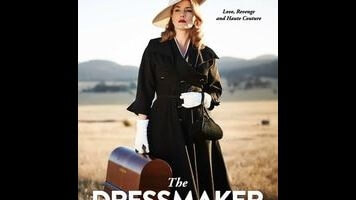Moorhouse adapted Rosalie Ham’s novel of the same name with writer P.J. Hogan, and cast Kate Winslet as the heroine, Myrtle “Tilly” Dunnage. As a child, Tilly was exiled from her tiny Australian town after being accused of murder. Now an exquisitely styled fashion designer, she doesn’t remember the details of what she did or didn’t do, but arrives back in Dungatar to care for her abandoned “mad” mother, Molly (Judy Davis), and excavate her past. While she’s there, she gives its dreary denizens makeovers, gets wooed by the hunky Teddy (Liam Hemsworth), and inspires chaos and a body count. Yeah, it gets weird.
It’s clear why Winslet would want to tackle Tilly: She’s fierce and tormented, and the actress brings her typical nuance to the part. She’s matched by a skilled cast turning in competent if not remarkable work. Davis’ disheveled and drunken Molly starts as a caricature, but grows more nuanced as the plot moves along. Hemsworth has a convincing romantic-lead swagger, even though the script never bothers to explain why Teddy takes such a liking to the interloper. His abs don’t look half bad either, and Moorhouse takes the opportunity to put them on display. Still, even as man candy, he can’t match the appeal of Hugo Weaving as Sergeant Farrat, the cross-dressing police officer who covets Tilly’s care packages. His character is outdated—the audience is supposed to titter at the fact that a man likes dressing in women’s outfits—but Weaving’s warmth helps mitigate the staleness. (If you care to really get worked up about nasty stereotypes, look to Gyton Grantley’s Tropic Thunder-evoking performance as Teddy’s mentally disabled brother Barney.)
Teddy and Farrat are among the few members of Dungatar’s populace who don’t immediately ostracize Tilly. The rest of the community is made up of cartoonish folk whose villainy is outlandish. To establish the awfulness of local politico Evan Pettyman (Shane Bourne), for instance, Moorhouse includes an unnecessary scene of him raping his drugged and unconscious wife. The moment is horrifying, but it’s treated as a throwaway gag. The vicious school teacher (Kerry Fox) gives Matilda’s Miss Trunchbull a run for her money when it comes to sniveling mistreatment of youth.
The film is most successful when it’s playing dress-up, less so when the comedy goes black, and worst off when it attempts melodrama. It doesn’t embrace its macabre elements enough to justify their randomness, and is weighted down by the predictable and turgid mystery of whether Tilly was a pint-size killer. Yet it’s hard to completely write off a piece that features a glorious frame of Winslet, fabulously be-hatted, viciously smoking a cigarette in front of a flaming backdrop. These kinds of images are The Dressmaker’s biggest asset, as are—of course—the costumes. Margot Wilson and Marion Boyce teamed up to create the magnificent frocks, Wilson tackling Winslet’s alone, and Boyce the rest. Boyce has said that allusions to fashion photographers Irving Penn and Richard Avedon were intentional. If only clothes made the movie.

